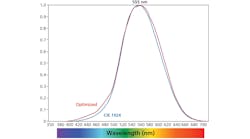The findings are reported in a market study from Frost & Sullivan (study A779-18, "Analysis of the North American Automotive Lighting Technologies Markets", published October 2004) focusing on North American-made vehicles, i.e. those for which final assembly is in Canada, Mexico, and the United States. Imported vehicles are not included in market size estimates, although foreign-nameplate vehicles made in North America are included.
Success in the North American automotive lighting technologies market depends on how efficiently participants can introduce new technologies while helping automakers achieve their cost reduction targets. Manufacturers of advanced lighting technologies strive to contain costs while allowing automakers to not only differentiate their vehicles stylistically but also from a safety point of view. Overall revenue in this market was $1.66 billion in 2004 and is projected to reach $2.11 billion in 2010.
Safety and comfort
Significant advances in light source technology such as high-intensity discharge (HID) headlights, LED rear combination lamps and third brake lights, adaptive front lighting (AFL) systems, LED-based front lighting, and night vision (NV) systems offer improved road safety and driver comfort.
"Safety is now a key selling point, and advanced lighting systems enhance safety in a number of ways," says Frost & Sullivan Senior Industry Analyst Joerg Dittmer. "An example is that LED brake lights illuminate more quickly; a vehicle is less likely to get rear-ended if the driver behind sees the brake lights come on a fraction of a second earlier."
Dittmer says that the market will see more LEDs in rear clusters, and side marker lights, but forward lighting is still a good number of years away. "The European automotive industry is ahead of the US in terms of adopting new technology including LEDs," he says. "North American consumers tend to be much more price-sensitive and less impressed with new technology."
For CHMSLs, the trend of LEDs displacing incandescent bulbs will progress slowly over time. Dittmer estimates that the number of vehicles produced with LED-based rear combination lamps (RCLs) will increase from 1% in 2003 to 10.3% in 2010. In contrast, 21.5% of vehicles produced in 2003 had LED-based CHMSLs and this is set to increase to 54.9% in 2010. Further growth in both applications is expected beyond 2010.
LEDs are still not fully price competitive, but the advantages of LED-based units justify a price premium. The limited penetration of LEDs in RCLs is due to cost. "I think it's a question of automating production to bring costs down," says Dittmer.
Trends indicate that prices will decline for LED-based units as volumes build, while they will slowly rise for incandescent-based units since these are mature products. For example, RCLs with LEDs are expected to decrease from around $50 in 2003 to $33 in 2010, while incandescent RCLs will increase in price from $13.80 to $15.20.
LEDs, having proven themselves in CHMSLs, are increasingly being used in instrument panels and other interior applications. Long life is a particular advantage in hard-to-reach places such as instrument panels, and low heat production is similarly an advantage.
Forward lighting
Most lighting manufacturers are evaluating LEDs for forward lighting applications, but performance is not where it needs to be, and cost targets are far from being met.
"We expect white LEDs for forward lighting to appear in production vehicles sometime in the 2010-2014 timeframe (2012 in our mid-line forecast)," says Dittmer. "However, we expect LED-based daytime running lights to appear in 2007 in North American-made vehicles."
LED forward lighting is expected to be used in high-end (luxury) vehicles first, then spread from there to mid-range vehicles as the technology becomes more cost-competitive. White LEDs probably will be more a competitor to high intensity discharge (HID or xenon) forward lighting than to incandescent lighting, since HID forward lighting systems also are fairly expensive.
Dittmer expects that, by 2012, white LED forward lighting will be about twice as expensive as HID technology, which will in turn be twice the price of halogen lighting.
In the United States, regulations do not ban LEDs for forward lighting per se, but requirements on beam patterns have to be met (unless the requirements are revised to accommodate white LEDs). Dittmer notes that limits on light output were raised in the past so that xenon (HID) headlights became legal - thus, revising regulations is not necessarily a huge hurdle.




